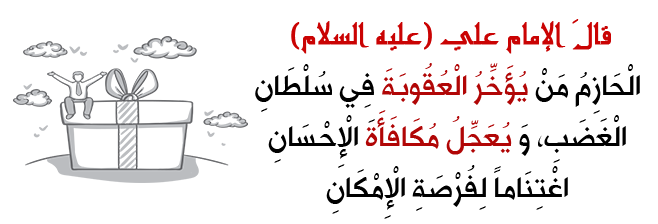


 النبات
النبات
 الحيوان
الحيوان
 الأحياء المجهرية
الأحياء المجهرية
 علم الأمراض
علم الأمراض
 التقانة الإحيائية
التقانة الإحيائية
 التقنية الحيوية المكروبية
التقنية الحيوية المكروبية
 التقنية الحياتية النانوية
التقنية الحياتية النانوية
 علم الأجنة
علم الأجنة
 الأحياء الجزيئي
الأحياء الجزيئي
 علم وظائف الأعضاء
علم وظائف الأعضاء
 الغدد
الغدد
 المضادات الحيوية
المضادات الحيوية|
Read More
Date: 29-4-2021
Date: 17-5-2016
Date: 21-4-2016
|
Activators Interact with the Basal Apparatus
KEY CONCEPTS
- The principle that governs the function of all activators is that a DNA-binding domain determines specificity for the target promoter or enhancer.
- The DNA-binding domain is responsible for localizing a transcription-activating domain in the proximity of the basal apparatus.
- An activator that works directly has a DNA-binding domain and an activating domain.
- An activator that does not have an activating domain may work by binding a coactivator that has an activating domain.
Several factors in the basal apparatus are targets with which activators or coactivators interact.RNA polymerase may be associated with various alternative sets of transcription factors in the form of a holoenzyme complex.
The true activator class of transcription factors may work directly when it consists of a DNA-binding domain linked to a transcriptionactivating domain. In other cases, the activator does not itself have a transcription-activating domain (or contains only a weak activation domain), but binds another protein—a coactivator—that has the transcription-activating activity. FIGURE 1. shows the action of such an activator. Coactivators can be regarded as transcription factors whose specificity is conferred by the ability to bind to proteins that bind to DNA instead of directly to DNA. A particular activator may require a specific coactivator.
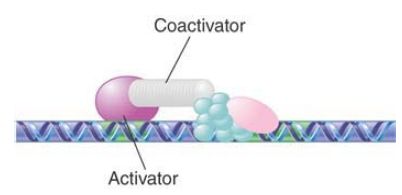
FIGURE 1. An activator may bind a coactivator that contacts the basal apparatus.
Although the protein components are organized differently, the mechanism is the same. An activator that contacts the basal apparatus directly has an activation domain covalently connected to the DNA-binding domain. When an activator works through a coactivator, the connections involve noncovalent binding between protein subunits . The same interactions are responsible for activation, irrespective of whether the various domains are present in the same protein subunit or divided into multiple protein subunits. In addition, many coactivators also contain additional enzymatic activities that promote transcription activation, such as activities that modify chromatin structure .
An activation domain works by making protein–protein contacts with general transcription factors that promote assembly of thebasal apparatus. Contact with the basal apparatus may be made with any one of several basal factors, but typically occurs with TFII D, TFII B, or TFIIA. All of these factors participate in early stages of assembly of the basal apparatus . FIGURE 2 illustrates the situation in which such a contact is made. The major effect of the activators is to influence the assembly of the basal apparatus.
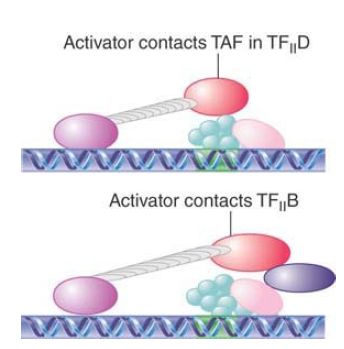
FIGURE 26.9 Activators may work at different stages of initiation by contacting the TAFs of TFII D or by contacting TFII B.
TFII D may be the most common target for activators, which may contact any one of several TAFs. In fact, a major role of the TAFs is to provide the connection from the basal apparatus to activators. This explains why the TATA-binding protein (TBP) alone can support basal-level transcription, whereas the TAFs of TFIID are required for the higher levels of transcription that are stimulated by activators. Different TAFs in TFIID may provide surfaces that interact with different activators. Some activators interact only with individual TAFs; others interact with multiple TAFs. We assume that the interaction assists the binding of TFIID to the TATA box, assists the binding of other basal apparatus components around the TFIIDTATA box complex, or controls the phosphorylation of the Cterminal domain (CTD). In any case, the interaction stabilizes the basal transcription complex, speeds the process of initiation, and thereby increases use of the promoter.
The activating domains of the yeast activator Gal4 and others have multiple negative charges, giving rise to their description as “acidic activators.” Acidic activators function by enhancing the ability of TFII B to join the basal initiation complex. Experiments in vitro show that binding of TFIIB to an initiation complex at an adenovirus promoter is stimulated by the presence of Gal4 or other acid activators, and that the activator can bind directly to TFIIB. Assembly of TFIIB into the complex at this promoter is therefore a rate-limiting step that is stimulated by the presence of an acidic activator.
The resilience of an RNA polymerase II promoter to the rearrangement of elements, and its indifference even to the particular elements present, suggests that the events by which it is activated are relatively general in nature. Any activators whose activating region is brought within range of the basal initiation complex may be able to stimulate its formation. Some striking illustrations of such versatility have been accomplished by constructing promoters consisting of new combinations of elements.
How does an activator stimulate transcription? Two general types of models can be considered:
The recruitment model argues that the activator’s sole effect is to increase the binding of RNA polymerase to the promoter. An alternative model is to suppose that the activator induces some change in the transcriptional complex; for example, in the conformation of enzymes such as protein kinases, which increases its efficiency.
If all the components required for efficient transcription are added up—basal factors, RNA polymerase, activators, and coactivators—the result is a very large apparatus that consists of ~40 proteins. Is it feasible for this apparatus to assemble step by step at the promoter? Some activators, coactivators, and basal factors may assemble stepwise at the promoter, but then they may be joined by a very large complex consisting of RNA polymerase preassembled with further activators and coactivators, as illustrated in FIGURE 3.
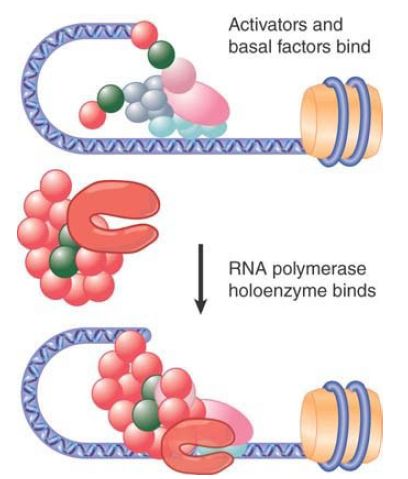
FIGURE 3. RNA polymerase exists as a holoenzyme containing many activators.
Several forms of RNA polymerase in which the enzyme is associated with various transcription factors have been found. The most prominent “holoenzyme complex” in yeast (defined as being capable of initiating transcription without additional components) consists of RNA polymerase associated with a 20-subunit complex called Mediator. Mediator includes products of several genes in which mutations block transcription, including some SRB loci (so named because many of their genes were originally identified as suppressors of mutations in RNA polymerase B, another name for pol II). The name was suggested by its ability to mediate the effects of activators. Mediator is necessary for transcription of most yeast genes. Homologous complexes are required for the transcription of most genes in multicellular eukaryotes as well. Mediator undergoes a conformational change when it interacts with the CTD of RNA polymerase. It can transmit either activating or repressing effects from upstream components to the RNA polymerase. It is probably released when a polymerase starts elongation. Some transcription factors influence transcription directly by interacting with RNA polymerase or the basal apparatus, whereas others work by manipulating the structure of chromatin .
Thus far, the discussion of gene regulation has focused solely on protein factors. However, in many cases noncoding RNA and antisense transcripts also participate in gene regulation . Another RNA-dependent pathway that has been implicated in gene regulation and chromatin structure is RNA interference (RNAi). Recent data in Drosophila demonstrate the involvement of the processing machinery for RNAi—Dicer and Argonaute—associated with chromatin at actively transcribed heatshock loci. Furthermore, mutations that inactivate this machinery lead to problems with RNA polymerase II positioning properly at the promoter. Sequencing of RNAs associated with Argonaute show small RNAs originating from both strands of the promoter region.
On a global scale, transcription that takes place in a nucleus is not scattered randomly throughout at sites of individual genes, but rather is seen to occur in large foci sometimes called transcription factories. As discussed in the Chromosomes chapter, individual chromosomes are not scattered randomly throughout the nucleus, but rather reside in chromosomal domains. New imaging techniques, including chromatin interaction analysis by paired-endtagged sequencing, or ChIA-PET, allow researchers to examine interactions between distal loci, including enhancers and promoters.
These interactions, seen in human cells, can be surprisingly long range—intragenic, extragenic, and even intergenic. Enhancer–promoter interactions were described earlier. Also seen now are promoter–promoter interactions between both nearby and distal genes, as shown in FIGURE 4. The data suggest the intriguing possibility that perhaps eukaryotes do possess a physical mechanism, the chroperon, to coordinate the expression of multiple genes similar to the operon model in prokaryotes.
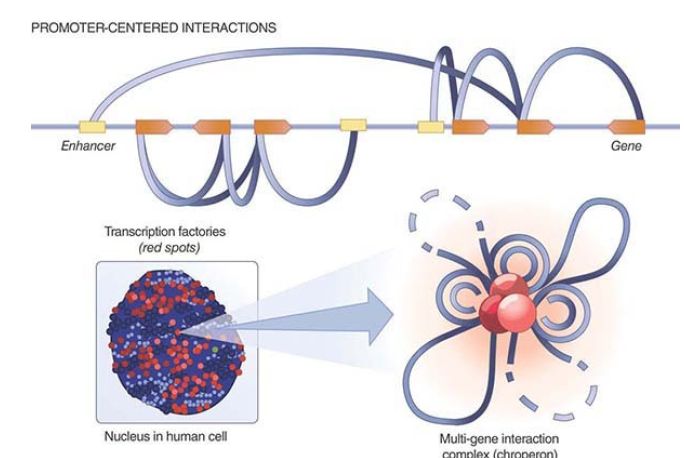
FIGURE 4.Higher-order chromatin interactions synergistically promote transcription of clustered genes. These interactions indicate a topological, combinatorial mechanism of transcription regulation.
Modified from Cell 148 (2012): 1–7.



|
|
|
|
إجراء أول اختبار لدواء "ثوري" يتصدى لعدة أنواع من السرطان
|
|
|
|
|
|
|
دراسة تكشف "سببا غريبا" يعيق نمو الطيور
|
|
|
|
|
|
بالفيديوغراف: ممثل المرجعية الدينية العليا والامين العام للعتبة الحسينية يتفقدان مشروع مطار كربلاء الدولي
|
|
|
|
بالصور: سنابل تفيض بالخير في مزارع العتبة الحسينية (عمليات حصاد الحنطة)
|
|
|
|
تضمنت الجولة توجيهات متعلقة براحة المسافرين.. ممثل المرجعية العليا والامين العام للعتبة الحسينية يطلعان ميدانيا على سير العمل في مطار كربلاء الدولي
|
|
|
|
بالفيديو: مركز لعلاج العقم تابع للعتبة الحسينية يعلن عن أجراء (117) عملية تلقيح اصطناعي خلال الربع الاول من العام الحالي
|